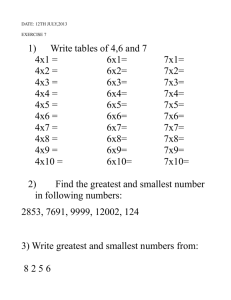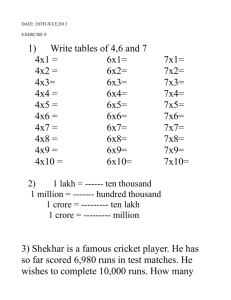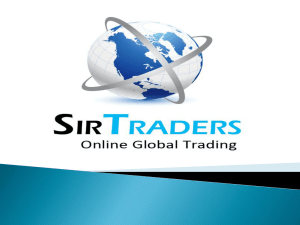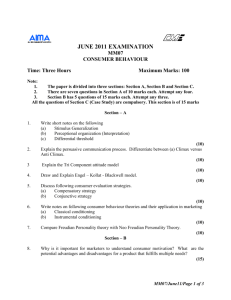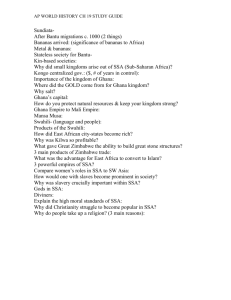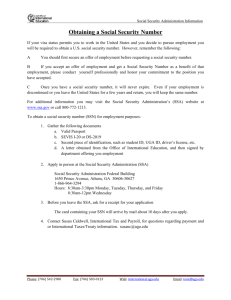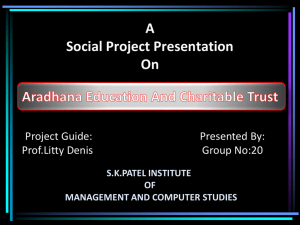(2003-04) to 45.80% (2005-06).
advertisement
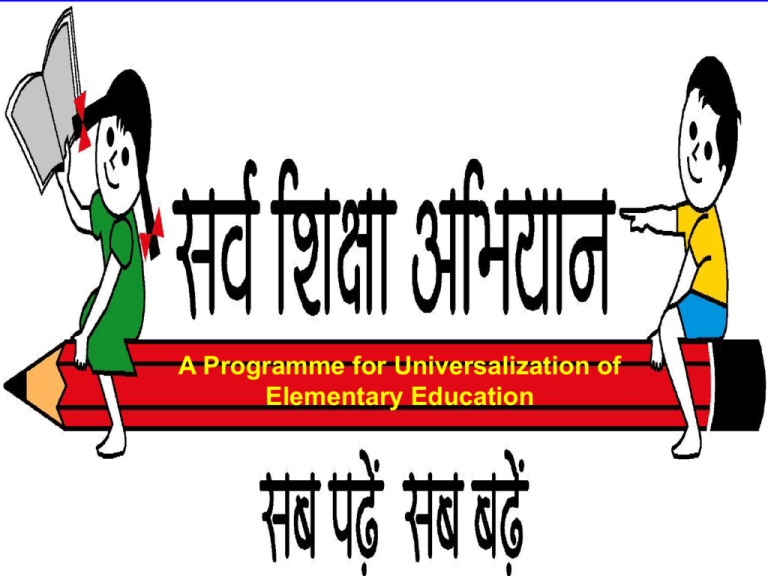
A Programme for Universalization of Elementary Education Mission Statement • • Empowering of children to be active participants in a knowledge society. A result-oriented approach with accountability towards performance and output at all levels. • A people-centred mode of Implementation of educational interventions with involvement of all stakeholders, especially teachers, parents, community and Panchayati Raj institutions and voluntary organisations. • An equity-based approach that focuses on the needs of educationally backward areas and disadvantaged social groups including children with special needs. • A holistic effort to ensure convergence of investments and initiatives for improving the efficiency of the elementary education system. Institutional reforms and capacity building to ensure a sustained effort for UEE. • SSA GOALS • All children in school, Education Guarantee Centre, Alternate School, ‘Back-to-School’ camp by 2005 • Bridging gender and social gaps in: Primary Elementary • : 2007 : 2010 Universal retention by 2010 • Focus on satisfactory quality with emphasis on education for life SSA NATIONAL MISSION PRIME MINISTER Governing Council HRM, FM, Dy. Chairman Planning Commission 3 Ministers of State 3 MPs 6 Political Parties’ Reps. 6 Edu. Ministers of State Govts. NCERT NUEPA NCTE IGNOU TSG(Ed.CIL) 6 Teacher Union reps. Minister for Human Resource Development Executive Committee SECRETARY SE & L Project Approval Board Joint Secretary & DG SSA Department of SE & L 5 Educationists/Scientis ts 6 NGO reps. 3 Women’s Org. Reps 3 Institutional Members working for SC & ST Reps of National Resource Insts Ex-officio members Monitoring Institutions Joint Review Missions Educational & Prog. MIS Goal 1: All children in School What does SSA Provide Providing basic facilities in each school Primary schools within 1 k.m. radius and a n upper primary school in the ratio of 2: 1 PS:UPS Education Guarantee Scheme and Alternative Innovative Education centres as alternative schools. Additional classrooms – a room for every teacher with minimum of 2 teachers at Primary and 3 teachers at Upper primary level Toilets/drinking water/child friendly elements. Additional teachers to get pupil teacher ratio of 40:1. Goal – I : All Children in School / EGS / AIE by 2005 Gross Enrolment Ratios pry 105 103.77 100 GER at upper primary stage is 64. 97.82 95 90 Lowest GER are in Bihar, Punjab, Haryana, Goa and A&N Islands 89.83 85 80 2003-04 GER at primary stage is 103.7 2004-05 2005-06 GER at Primary Level Huge enrolment Increase in Chattisgarh, Jharkhand, Rajasthan, Madhya Pradesh. Goal – I contd…/- Out of School Children The number of out of school children is 76 lakh (2007). In lakhs 350 320 300 250 249 200 150 100 116 135 70 75 50 0 2001- 2002- 2003- 2004- 2005- 200602 03 04 05 06 07 3.8% OoSC – “hardest to reach” category of children. 60% OoSC are in Bihar, West Bengal and Uttar Pradesh. No. of districts>50,000 OOSC – 36. Plan to cover 11 lakh through EGS and 48 lakh through AIE this year. Goal – I : All Children in School / EGS / AIE by 2005 Infrastructure Targets up to 2006-07 (in lakh) Item Access at Primary Stage Access less (no school within 1 1,60,528 km.) habitations as per 7th AIES New Schools opened 2.40 Primary schools provided till 2007-08 under SSA and DPEP Teachers appointed 10.03 Number of EGS centres functional by the end of 2007-08 is 57,000 Drinking Water 1.7 Toilets 2.35 Construction School building Additional Classrooms 1.83 6.92 Access at Upper Primary Stage Access less (no school within 3 km.) habitations as per 7th AIES Upper Primary Schools provided till 2007-08 under SSA 2,04,200 1,69,492 124300 PS to UPS at the National level is 2.6:1 States Advised to map requirements of UPS as per distance and population norms Thrust in 11th Plan Identify and mainstream ‘hard to reach’ children •Focus on bridge courses / programmes. •Address residual access •Fill infrastructure gaps – priorities upper primary schools 6.37 lakh additional classrooms for SCR 1:40 Goal 2: Bridging Gender and Social Category Gaps Programme for participation of girls Free Text Books National Programme on Education of Girls at Elementary level started in 3291 educationally backward blocks. Innovative activities like pre-school centres/bridge courses/vocational education/bicycles etc. Gender sensitization teachers. Kasturba Gandhi Balika Vidyalaya (residential schools) in 2810 educationally backward blocks . Innovative activities in several States – Life skills education, remedial teaching, vocational training for older girls, health and hygiene camps and uniforms / incentives. of education personnel and Goal – II : Bridging Gender & Social Category Gap at primary by 2007 & elementary by 2010 Upper Primary Primary • Girls enrolment up from 45.02% • Girls enrolment up from 47.18% (2003-04) to 45.80% (2005-06). (2003-04) to 47.79% (2005-06). • Gender gap reduced at upper • Gender gap reduced at Pry primary (DISE) 2003-04 2004-05 2005-06 2003-04 2004-05 2005-06 9.4 8.9 8.0 5.1 5.1 4.6 • 81 distt. Gender gap > 20% pts. • High gender gap in: Rajasthan(23.6)Bihar (22.3) Jharkhand(11.8)MP(11.7) Uttar Pradesh (9.4) • 48 distt. Gender Gap > 10% pts. • High gender gap Bihar(11.3)Rajasthan (7.07) Gujarat(6.1)Jharkhand (5.0) Goal – II contd…/- Promoting Education of SC and ST Children • Free Text Books. • 242 KGBV in SC and 457 in ST Blocks with 25% of SC & 29% ST girls covered in all KGBVs. • Rs. 15 lakh per district for SC/ST innovation. • EGS & AIE centres being opened in tribal areas with relaxed norms (10-15 children). • Recruitment of local tribal teachers. • Development of specific modules for training of teachers in tribal areas (AP, Gujarat, Orissa). • Use of primers in tribal languages to help in better transition to State language. • Targeted Provisioning in 61 SC & 106 ST concentration districts Goal – II contd…/- Share of SC and ST Students Primary Upper Primary 2003-04 2004-05 2005-06 2003-04 2004-05 2005-06 SC 21.3% 20.75% 20.40% 19.33% 20.10% 19.09% ST 10.20% 10.71% 11.55% 8.08% 8.84% 8.76% *Source DISE data. • Highest SC share in Punjab (47%), Haryana (31%), UP (28%). • Highest ST share in North Chhattisgarh, Orissa, Jharkhand. • Gender Parity an issue at upper primary level among SC. • Gender parity an issue at primary & upper primary level among ST. Eastern States, What Does SSA Provide for Children With Special need • • • • • • • • Support to CWSN, specific provision of Rs 1200 per child Coverage through enrolment in schools(19.97 lakh), EGS/AIE centres(1.12 lakh) and home based education (77140). Provided assistive devices to 7.12 lakh CWSN Teachers training to 50000 teachers 6678 resource teachers appointed in 21 States. Barrier free access ramps in the 5.02 lakh school 620 NGOs involved in planning for IE, identification on CWSN, provision of aids and appliances, training on teachers etc. Focus now on in-class attention and appropriate materials/ teaching methods for enrolling CWSN CWSN – Inclusive Education • SSA has zero rejection policy 3500000 3000000 2500000 2000000 1500000 1000000 500000 0 2002-03 2003-04 2004-05 2005-06 2006-07 Identified 683554 1459692 1592722 2017404 3038038 Covered 566921 1171993 1424310 1560539 2049367 Thrust in 11th Plan Lower Gender Gap in literacy by 10% pts. • Revamp NPEGEL for specific block projects @ Rs. 25 lakh per block per year. • Enlarge eligibility criteria of EBB’s for NPEGEL & KGBV Bring SC, ST at par. • Small school norms for ST areas. • Hostels for boys @ KGBV norms. (ST & Minorities Focus on minority dominated areas. • Priority targeting for completing infrastructure gaps in districts / blocks with socially disadvantaged categories. Enhance CWSN norms and Focus on Girl Child with Disability Goal III : Universal Retention by 2010 18 16 • Dropout rates (pry.) have declined by 4.5 percent points. • Reduction in girls drop out by 5 percent points. • Transition rates Pry. to U. Pry. improve from 74.15 (2003-04) to 83.36 (200506). 14 12 10 8 6 4 2 0 Pry Girls Primary 2002-03 2003-04 2004-05 15.26 14.9 13.06 12.79 10.21 10.39 *DISE Dropout Rates Goal III : Universal Retention by 2010 Upto 5% 5 to 10% 10 to 15% 16 to 20% > 20% Drop out at Pry Level 9.96% < 10 AP, HP, Chattisgarh, Gujarat, J&K Karnataka, Kerala, MP, Maharashtra, Mizoram, Nagaland, Orissa, Punjab, Sikkim, Tamilnadu, Tripura 10 – 15 Assam, , Haryana, UP, WB Uttarakhand, > 15 Jharkhand, Bihar Meghalaya , Rajasthan Arunachal Pradesh Thrust in XIth Plan – Universal Retention Dropout to reduce from 52.2% (2003-04) to 20% (201112) at elementary level. Incentivise Upper Primary Level • Library infrastructure • More staff at BRC for upper primary requirements. • Special teacher training for upper primary schools. • Free text books and uniforms to all • Furniture for every child • Special focus on science and maths learning. • Enhanced ICT input. Goal IV: Improving Quality of Education What SSA Provides for Quality improvement Provide additional teachers for PTR 1: 40 with minimum of two teachers Grants – Teachers Development of improved textbooks Free textbooks for girls, SC, ST’s Remedial teaching (for students needing greater attention ) Annual 20 day training of teachers Decentralized academic support to schools/teachers through block & cluster level resource centers Improved pupil assessment systems School monitoring indicators Goal IV: Improving Quality of Education States with high PTR PTR at primary – 41:1 and at upper primary is 29:1 State have recruited 7.98 lakhs teachers against the target of 10.12 lakhs teachers. PTR more than 41:1 at elementary level Goal – IV contd../- Progress against Quality Inputs Target (2006-07) Teacher Training 34.05 lakh teachers TLE Grant 1.08 lakh schools School Grant 10.1 lakh schools TLM Grant 39.34 lakh teachers Free Textbooks 6.68 crore students Remedial training 43.60 lakh students Functional BRCs 6746 centres Functional CRCs 70388 centres % Achievement 87% 62% 95% 90% 96% 78% 99% 94% Assessment based learning improvement efforts Learning Improvement Initiatives Recent initiatives Quality Tracking in Kerala KSQAO – Karnataka ABL – Tamil Nadu CLAPS – Andhra Pradesh LATS – Orissa GAP – Gujarat Buniyad – Jharkhand Read C. – Chhattisgarh Read M. – Madhya Pradesh LAP, LGP – Rajasthan School Grading, Nayee Disha – UP PLEP – Punjab SSUU – West Bengal Bidya Jyoti, LAP – Assam School Monitoring - Uttarakhand Thrust in 11th Plan Working Group: On Quality • • • • • Develop minimum standards of educational attainment Regular testing to monitor effectiveness of education. ICT for enhancing learning levels. Define ‘improved quality’ in operational terms. Distinguish assessment for performance of individual students, grading school effectiveness & teachers & learner achievement trends, national Surveys for quick comparable results / analysis on direction of learning outcomes. • Acquisition of basic skills of literacy & numeracy in early primary grades. • Creation of capacity within the school for dealing with ‘diversity’ in students. • Enhance SSA’s framework to support more quality related activities. Contd. What Does SSA Provide for Community Involvement Community involvement - must in SSA Village Education Committees and School Management Committees given key role in SSA implementation. 50% funds go to VEC/ SMC VECs/Women’s groups monitor primary schools Roles in implementation/monitoring assigned to Panchayati Raj Institutions. More than 6000 NGOs involved in support to, and implementation of SSA interventions. Thrust in 11th Plan : Community Participation Road map for decentralisation of school governance with defined milestones. Community control over recruitment & placement of teachers. Block based / school based cadres.\ Substitute teachers. Development of annual school plans with community involvements, with clear focus on quality parameters. 1% of districts outlay for community mobilisation activities. Promoting participation of NGOs and private sectors in providing facilities for deprived urban children. Educational Development Index (EDI) 1st quartile 2nd quartile 3rd quartile 4th quartile District EDI Distribution Per cent districts in different Quartiles State/UT Quartile 1 Quartile 2 Quartile 3 Quartile 4 Himachal Pradesh 100.00% 0.00% 0.00% 0.00% Sikkim 100.00% 0.00% 0.00% 0.00% Tamil Nadu 96.60% 3.40% 0.00% 0.00% Delhi 88.90% 11.10% 0.00% 0.00% Mizoram 75.00% 12.50% 12.50% 0.00% Karnataka 66.70% 25.90% 7.40% 0.00% Andhra Pradesh 56.50% 30.40% 8.70% 4.30% Uttarakhand 53.80% 38.50% 7.70% 0.00% Punjab 52.90% 47.10% 0.00% 0.00% Maharashtra 45.70% 51.40% 2.90% 0.00% J&K 35.70% 21.40% 42.90% 0.00% Gujarat 32.00% 60.00% 8.00% 0.00% Nagaland 12.50% 12.50% 25.00% 50.00% Manipur 11.10% 33.30% 44.40% 11.10% Monitoring/ Feedback EMIS for 2006-07 under compilation (received from 25 States / UTs). School Report Cards 2006-07 on website. 56 MI Reports received for 28 States / UTs (on website) IPAI Reports received for 21 States. CAG Performance Audit responded to & evidence on 13th Feb’07. PAC Report received. 9 Independent Assessment Studies initiated. 30
